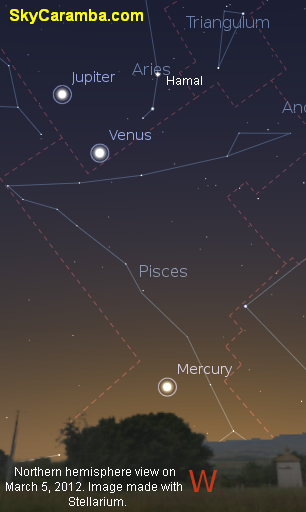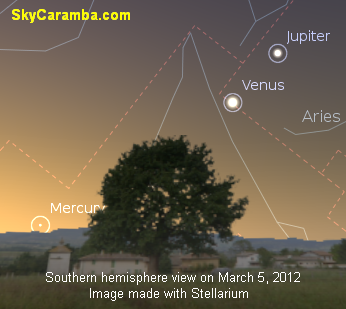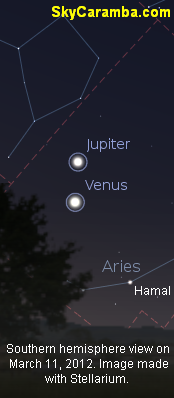SkyCaramba weekly astronomy blog for the week ending March 10, 2012
 This is the week that Venus nearly catches up to Jupiter in northern hemisphere evening skies. They are the two brightest objects in the western sky after the sun goes down. You’ll see them long before darkness fully sets in.
This is the week that Venus nearly catches up to Jupiter in northern hemisphere evening skies. They are the two brightest objects in the western sky after the sun goes down. You’ll see them long before darkness fully sets in.
At the start of the week, Venus is a little below Jupiter. In the northern hemisphere, Venus will also appear a little to the right. Venus will make steady progress night by night until next Sunday, the 11th, it’s almost exactly to the right of Jupiter for northern viewers.
I stress the above is for northern viewers, because if you’re looking from far south of the equator, Venus will look like it’s quite a bit left of Jupiter. Venus will keep marching rightward and will end up beneath Jupiter by next weekend.
 Venus is about 0.85 earth-sun distances from us this week. Jupiter is about 5.5 earth-sun distances away. Try to visualize how Venus is just coming around to this side of the sun while Jupiter is still way around on the other side. It’s kind of like how a telephone pole can be just a few feet away from you as you drive by on the highway but a mountain top a mile off could actually appear to be side by side with it for a moment.
Venus is about 0.85 earth-sun distances from us this week. Jupiter is about 5.5 earth-sun distances away. Try to visualize how Venus is just coming around to this side of the sun while Jupiter is still way around on the other side. It’s kind of like how a telephone pole can be just a few feet away from you as you drive by on the highway but a mountain top a mile off could actually appear to be side by side with it for a moment.
Look at Jupiter through binoculars or a telescope. You’ll see up to four tiny dots next to it. From night to night, one of the dots switches sides of the planet. That’s the moon Io. The other moons are farther away from Jupiter and take longer to orbit the planet. You’ll see some of these moons disappear in Jupiter’s shadow from time to time. Or if you have a big enough telescope, you will see the moons cast their own shadows on Jupiter’s upper atmosphere.
 At the start of the week, you may get a fleeting glimpse of Mercury. The messenger planet will be barely above the horizon below Jupiter and Venus from middle northern latitudes. From southern latitudes, it will be way to the left of the other two planets. It won’t stay long. It’s at its greatest elongation, 18.2° east of the sun, on the 5th. Mercury is 0.9 earth-sun distances from us on that date.
At the start of the week, you may get a fleeting glimpse of Mercury. The messenger planet will be barely above the horizon below Jupiter and Venus from middle northern latitudes. From southern latitudes, it will be way to the left of the other two planets. It won’t stay long. It’s at its greatest elongation, 18.2° east of the sun, on the 5th. Mercury is 0.9 earth-sun distances from us on that date.
Near Venus and Jupiter is a second magnitude star called Hamal. That’s the Arabic word for lamb. It’s the brightest star in the constellation Aries. About 2,500 years  ago, the northern hemisphere’s spring began when the sun was close to where Hamal is. You will still be able to see Hamal on March 20, this year’s equinox. That should make it clear that things have changed over the centuries even though astrologers like to pretend the sun is in Aries at that time.
ago, the northern hemisphere’s spring began when the sun was close to where Hamal is. You will still be able to see Hamal on March 20, this year’s equinox. That should make it clear that things have changed over the centuries even though astrologers like to pretend the sun is in Aries at that time.
Look a little above Venus and Jupiter and you’ll see the Pleiades in a sort of Y-shaped formation. Keep going and you’ll see the V-shape of the Hyades. They are pieces of the constellation Taurus and Venus will keep heading toward Taurus after this week. ¡Sky Caramba!